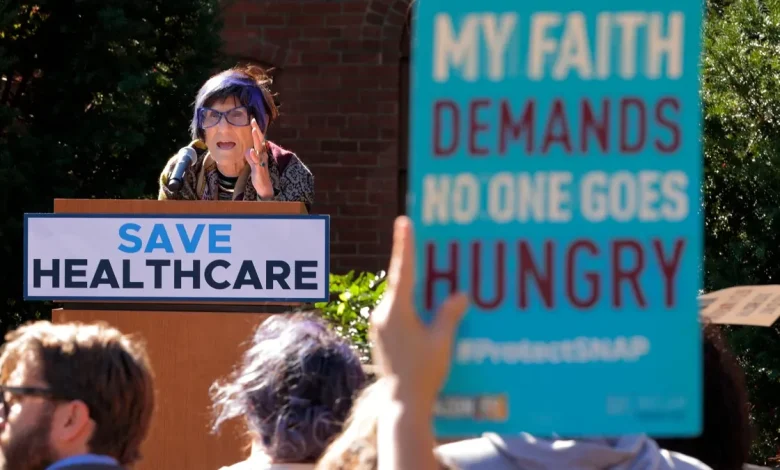The shutdown is about to end. Will millions lose their health insurance?

Trump supports Capitol Hill deal to end shutdown and reverse firings
President Donald Trump said he will support the Capitol Hill deal to reopen the government and reverse firings.
If you’re one of the millions of Americans enrolled in Affordable Care Act health insurance plans – frequently called “Obamacare” – you’re likely facing the prospect of sharply higher expenses next year with no guaranteed relief in sight.
A bipartisan deal to end a monthlong government shutdown doesn’t change that. The agreement to reopen the government pushes a decision on ACA affordability to December. That’s when Congress will decide whether to extend COVID-19 pandemic-era tax credits that make ACA plans more affordable. If the credits aren’t extended, they’ll expire at the end of 2025.
Though the change doesn’t directly affect the pocketbooks of most working-age Americans who get health insurance through their employers, the uncertainty and concerns about affordability will likely prompt some cost-conscious and healthier consumers to drop ACA coverage, experts said.
“Unfortunately, this deal is going to prolong uncertainty for millions of Americans who get their insurance through Affordable Care Act,” said Sabrina Corlette, co-director of Georgetown University’s Center on Health Insurance Reforms. “Congress is almost guaranteeing that the marketplaces will lose enrollment of people that you want to keep − the young and healthy folks.”
Senate strikes deal to end historic government shutdown
Lawmakers agree to end longest-ever government shutdown, reopen government through Jan 30
Who does this affect?
KFF estimated 22 million Americans who get Obamacare tax credits will see their monthly premium payments more than double on average. That doesn’t mean the price tag of these ACA plans are doubling, but without the add-on subsidies, consumers will pay an average of $1,016 more in 2026. The final amount consumers will pay depends on their age, income, location and coverage level.
Why are consumers facing more expensive Affordable Care Act health insurance?
If Congress approves the bipartisan deal, the insurance tax credits will revert to original levels of the Affordable Care Act. Under President Barack Obama’s signature 2010 health care law, often called Obamacare, cost-saving tax credits were limited to those who earn up to four times the federal poverty level.
Congress temporarily approved more generous subsidies during the COVID-19 pandemic to ensure more Americans could afford health coverage.
With the pandemic-era subsidies ending, those who earn more than four times the federal poverty level must pay the full cost of their ACA plans. Lower-income Americans will still qualify for the Obama-era subsidies, but they won’t get the COVID-era subsidies that sharply reduced their out-of-pocket costs.
How much will insurance costs increase for ACA enrollees?
Health insurance companies typically raise rates based on the underlying cost of medical care and how often consumers get care from a doctor, hospital or fill prescriptions.
Insurers who sell plans on the ACA federal and state marketplaces are raising rates an average of 26% for 2026 plans, accor.ding to an analysis by KFF, a health policy nonprofit.
But the amount most ACA consumers pay out of pocket will increase at a faster rate with the pandemic subsidies expiring.
Those who earn more than four times the federal poverty level − $62,600 for an individual or $128,600 for a family of four − will have to pay the full amount. Those who earn less than four times the poverty level will get less financial help. In other words, they will get the original Obama-era subsidies based on a sliding scale share of their income.
What will happen to consumers who will be asked to pay more?
Consumers will have the option of switching to Obamacare plans that provide less generous benefits. An enrollees in a “silver” plan might choose a bronze plan that charges lower monthly premium but higher deductibles – the amount consumers must pay before coverage kicks in.
As many as 4.2 million Americans would drop ACA coverage due to the expiration of the pandemic-era credits, according to a June estimate by the nonpartisan Congressional Budget Office. Yet if the pandemic-era subsidies are extended, more than 3.4 million Americans would gain coverage each year through 2034, the CBO said.
Entrepreneurs who don’t have access to employer health insurance are among those who would suffer if the pandemic tax credits expire, according to the nonprofit Small Business Majority.
“An agreement that would reopen the federal government without renewing the Affordable Care Act’s enhanced premium tax credits deals a huge blow to the fortunes of small businesses in America,” said John Arensmeyer, the small business group’s founder and CEO.
Others who might face higher insurance bills include farmers and gig economy workers who don’t get coverage through the workplace, Corlette said.
Without the pandemic-era subsidies, ACA health insurers could face the prospect of serving a larger share of high-cost enrollees, Corlette said.
“We could be in for a stretch where insurance companies have to raise their premiums again to reflect a smaller and sicker market,” Corlette said. “So 2027 premiums are likely to be even higher, and some insurance companies may decide this is not a market they want to continue being in.”




![2025 Jiangxi Open: Blinkova [95th] vs. Bondar [74th] Prediction, Odds and Match Preview](https://cdn1.emegypt.net/wp-content/uploads/2025/10/2025-Jiangxi-Open-Blinkova-95th-vs-Bondar-74th-Prediction-Odds-390x220.webp)
